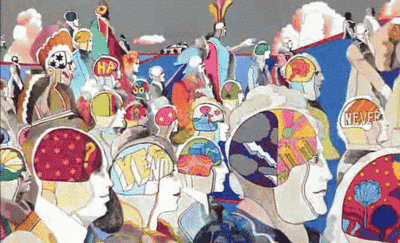"Lucy in the Sky with Diamonds" (Lennon-McCartney, 1967)
Although both John Lennon and Paul McCartney have insisted “Lucy in the Sky with Diamonds” was not inspired by LSD but by a drawing by Lennon’s son and Lewis Carroll’s Alice in Wonderland, it is undeniable that the song is about a “head trip.” In Yellow Submarine, “Lucy in the Sky” begins with The Beatles standing in the Foothills of the Headlands. Sloping tops of giant heads form these hills, and there are tens of them, each shown in profile with an exposed brain. The brains are colorful and varied—flags and flowers and six-pointed stars flash pink, purple, and turquoise in some brains while words such as, Freud, i, No, Maybe, and Yes No flash orange, blue, green, and yellow in others—making the Headlands a kaleidoscopic landscape from which Lucy and Lennon see. The opening lyrics reenforce the idea this journey is into the mind, as the speaker commands the listener to “Picture yourself on a boat on a river.” What follows are surreal images and lyrics— a chorus line spattered in stars dances with shadows and “newspaper taxis appear on the shore.” As the song concludes, Lennon exits the surreal landscape of the mind, and, layer by layer, the doors of perception shut, and Lennon continues on his other journey.
L.A. Woman
“L. A. Woman,” The Doors (Jim Morrison, Robby Krieger, Ray Manzarek, John Densmore, 1971)
There is a rhythm to every city; all significantly lived-in cities have a pulse. The City of Angels perhaps drove Jim Morrison’s own rhythm, as he drove its rhythm. The two had a great relationship: love, danger, drugs, and recklessness. John Densmore’s drums quickly engage with Ray Manzarek’s keyboards and Robby Krieger’s guitar, creating a tempo that drives, walks, and rides. (Note Morrison riding his bike and smoking--thinking about motels, money, murder, and madness.) Everything moves in Los Angeles, which is why its a city that has to be driven. Los Angeles is like a woman:
“I see your hair is burning
Hills are filled with fire
If they say I never loved you
You know they are a liar
Driving down your freeway.
Midnight alleys roam
Cops in cars,
The topless bars
Never saw a woman...
So alone, so alone.”
The masculinity in Morrison's lyrics, and the idea that Los Angeles is a woman to be "driven," is punctuated by lyrics about Mustangs, motels, and "Mr. Mojo Risin’" which escalates, "rising, riding," until we reach Morrison's mad “y-ye-ss” at minute 6:09. (We include the video directed by Ray Manzarek in 1985 for MTV.)
Road to Nowhere
"Road to Nowhere" (David Byrne, 1985)
The Talking Head’s “Road to Nowhere” provides a glimpse into a life lived unexamined. The opening lines explain, “Well, we know where we’re goin’/ But we don’t know where we’ve been/ And we know what we’re knowin’ / But we can’t say what we’ve seen.” This is a great ironic celebration of the meaningless journey taken on autopilot. The video, directed by Byrne and Stephen R. Johnson, visually echoes the endless recycling of the mundane life. It’s classic David Byrne. About “Road to Nowhere”, he said, “I wanted to write a song that presented a resigned, even joyful look at doom. At our deaths and at the apocalypse…(always looming, folks).”
Interstate 8
"Interstate 8" (Modest Mouse, 1996)
Northwest indie band Modest Mouse speaks to a generation that came of age when ephedrine was sold at filling stations, and the change scrounged from their seat cushions could buy enough gas for a road trip everywhere and nowhere. Relying on ironic lyrics, Modest Mouse’s road songs are about not just a physical journey but also a mental journey into intoxication, mental illness, boredom, and frustration caused by economic hardship and depression in a superficial world. So, when lead singer and songwriter Issac Brock licensed “Gravity Rides Everything” to Nissan for a Quest minivan commercial, many fans criticized him for selling out. But Brock responded, “People who don’t have to make their living playing music can bitch about my principles while they spend their parents’ money or wash dishes for some asshole.” As nearly all Modest Mouse’s albums and compilations have a road song, it’s difficult to pick just one, but “Interstate 8” is perhaps their most quintessential.
Songs worth mentioning include:
- “Ohio” (This is a Long Drive for Someone with Nothing to Think About, 1996)
- “Karma’s Payment” (The Fruit that Ate Itself, 1997)
- “Out of Gas” (The Lonesome Crowded West, 1997)
- “Trucker’s Atlas” (Lonesome Crowded West 1997)
- “A Life of Arctic Sounds” (Building Something out of Nothing, 1999)
- “Every Penny Fed Car” (Sad Sappy Sucker, 2001)
Little Deuce Coupe, 409, & I Get Around
The Beach Boys
- “Little Deuce Coupe” (Brian Wilson and Roger Christian, 1963)
- “409” (Brian Wilson, Mike Love, Gary Usher, 1962)
- “I Get Around” (Brian Wilson and Mike Love, 1964)
Although the Beach boys probably lead the universe in great driving songs, or at least in songs about cars, we chose this holy trinity because each song exemplifies not simply so much about the Beach Boys as musicians, but about the spirit of California, and even more specifically, about driving in California.
“Little Deuce Coupe,” celebrates a classic hot rod: a 1932 Ford Model B Coupe (for more on the history of hot rods and their particular connection to California see the invaluable The Nearest Faraway Place: Brian Wilson, the Beach Boys, and the Southern California Experience by Timothy White). The reference to “pink slip” was the title for the car. The track is pure driving joy with Dennis Wilson’s drumming, Al Jardine’s and Carl Wilson’s guitars, Brian Wilson’s bass, and of course, those mythical harmonies.
“409” reflects much of what the Beach Boys picked up from rhythm and blues artists and its rhythmic cadence is absolutely perfect for a nice drive down Sunset Boulevard (or you can pretend while you drive down some piece-of-shit contemporary American road). The 409 was the muscle beauty Chevy Impala SS 409 (“She’s real fine my 409,” of course!).
“I Get Around” celebrates the freedom and adventurousness of the road— the need to get in a nice car and drive around. This music is pheromone inducing as any in human history.
Honorable mention: “Shut Down” (Brian Wilson, Roger Christian, Mike Love, 1963) is a kind of narrative musical poem about a drag race between a Super-Stock 413, 1962 Dodge Dart, and a fuel-injected 1963 Corvette Sting Ray—mouth-watering stuff for classic car geeks!





